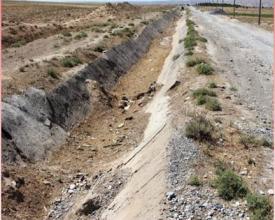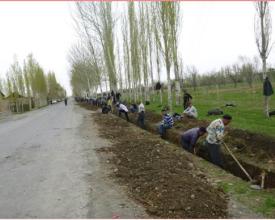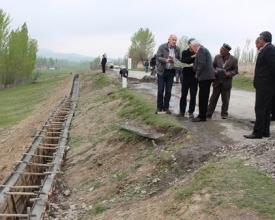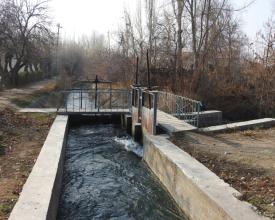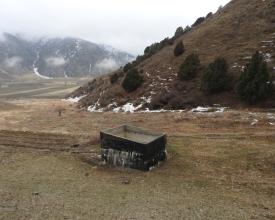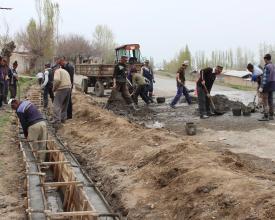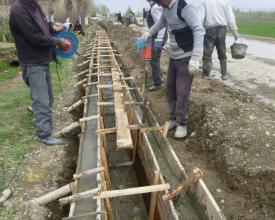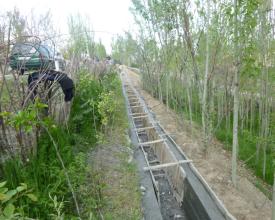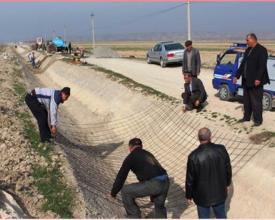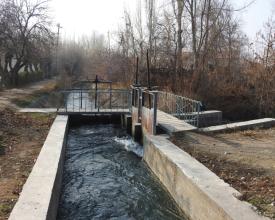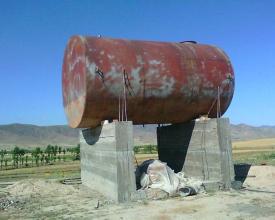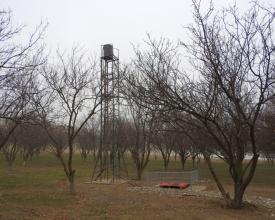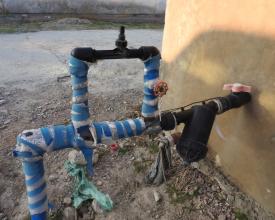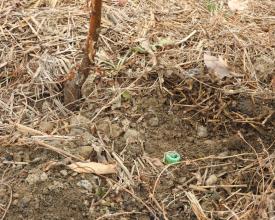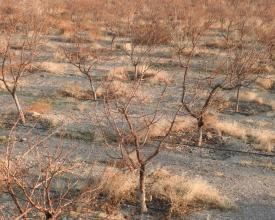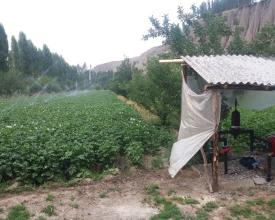
Increased efficiency of irrigation water use to address climate change related water shortage

Irrigated agriculture is often limited by the availability of irrigation water. In many irrigated areas the distribution canals and on-farm irrigation systems are in poor shape, which causes substantial water losses. These problems are increasingly exacerbated by the impact of climate change causing a reduction of available irrigation water with higher temperatures and expansion of irrigated agriculture leading to higher irrigation water demand. Increasing frequency and intensity of flashfloods and debris flows pose risks to the functioning of irrigation canals and thus to the livelihoods of farmers and food security.
The solution reduced the substantial losses of irrigation water caused by seepage from canals, structural problems in irrigation systems and on-farm irrigation. It also addresses risks caused by flashfloods and debris flows. The solution is based on a technical and financial support to the local communities in collaboration with district water management authorities.
Context
Challenges addressed
Communities, farmers and district administration did not have the financial means and technical capacity to implement improvement and adaptation to climate change impact of the elements of irrigation systems. For farmers the investment costs of efficient on-farm irrigation were prohibitive for testing these technologies. With the help of the project these challenges were addressed, external investment and technical input were combined with substantial contributions by communities and land users.
Location
Process
Summary of the process
The three building blocks address the key elements of irrigation water use - the source of water, the delivery and distribution systems and the on-farm use of the water for agricultural production. All three building blocks help to address climate change impact by achieving a more efficient use of irrigation water. The entire system of irrigated agriculture becomes thus less prone to the impact of irrigation water shortage and drought expected to become more freqent due to reduced and irregular rainfall, reduced storage of precipitation in snow fields and glaciers and higher summer temperatures. Additionally, in particular by the building block dealing with improvement of canals the increasing disaster risk is addressed, thus making the whole irrigation system more resilient.
In the practice some of the building blocks might be implemented independently, where only certain elements of the irrigation system require changes or improvement.
Building Blocks
Rehabilitation (lining) of canals to reduce seepage losses
Many irrigation canals are either made as earth canals only or the concrete lining is broken. Leaking canals lose substantial amounts of water, which is consequently not available for irrigation. Furthermore, if affected by flood and debris flows, such canals can easily break and cause substantial damage.
The communities and land users together with the district water management authorities chose the sections requiring reinforcement and lining. Works were implemented with technical and financial support by GIZ, which provided the engineers guiding the rehabilitation measures and financed the purchase and transportation of materials. Communities and land users carried out the works through "hashar", the joint communal voluntary work.
The rehabilitated irrigation canals provide safe and stable irrigation water supply, waterlogging and flooding of lands alongside the canals is prevented. The further maintenance is carried by the local communities through their mahalla (village commitees) and jamoats (communal self-governance structure at sub-district level).
Enabling factors
The combination of sound engineering knowledge and suitable materials - financed by the donor - with the willingness of the community members and land-users to contribute their time in form of voluntary work made the solution possible.
Lesson learned
The key for success is in the combination of good engineering skills and adequate materials with the work contribution of the local people. A fully externally funded and implemented rehabilitation would not have achieved the ownership and future maintenance. Thus it would likely have been less sustainable. On the other hand, without external engineering skills and provision of suitable materials the communities and land users would not have been able to implement the works in good quality.
Diversity of water sources
Irrigation water can be used from different sources. In the region, where the solution is implemented these are:
- the Syrdarya river, from where it is pumped through large pipelines;
- irrigation canals;
- wells;
- small springs, which are captured by simple means;
- rainwater collection from the roofs of houses.
The different water sources are related to a diversity of governance systems. The regional government owns and maintains large pipelines and canals, medium irrigation canals are in the responsibility of district water management authorities and smaller structures are cared for by the communities or by individual farmers.
Depending on the amounts of irrigation water available and the associated costs there are increasingly new and water efficient technologies applied for irrigation of the lands.
Enabling factors
The diversity of sources of irrigation water is an enabling factor by itself. Together with the availability of diverse technologies it allows for the continuation of irrigated farming under the conditions of climate changed induced increasing aridity and irrigation water shortage.
Lesson learned
Irrigated agriculture can be effective and efficient with different sources of irrigation water. Creative innovations and the application of best practices allow for the capturing of even small sources of irrigation water and their use for the cultivation of irrigation dependent crops and thus for generation of local income. By this the resilience of land users to the impact of climate change is improved.
Efficient irrigation technology
Conventional irrigation in the area of the solution had been furrow irrigation only. This technology requires large amounts of irrigation water. In cases of shortage of irrigation water, in particular in drought situations, which due to climate change are increasingly frequent, furrow irrigation is not possible - the water just cannot reach all parts of the field and be taken up by the plants.
In the case of potatos increasing heat causes stress to plants.
As more efficient and climate change adapted irrigation technologies of drip irrigation have been introduced. Drip irrigation allows for a locally targeted provision of irrigation water to individual plants. Additionally it can be used to apply fertilizer in correct dosage and extremely efficiently.
The sprinkler irrigation is highly suitable for potatoes and can help to reduce heat stress in cases where sufficient water of suitable quality is available.
Enabling factors
The readiness of farmers to try new irrigation technologies was much driven by the increasing awareness about the limitations of the conventional furrow irrigation, experience of water shortages and the policy of the national and regional governments to apply water efficient irrigation technologies, e.g. in the newly irrigated lands of Sayhun town, which are fully dependent on the costly pump irrigation with water from Syrdarya river. The need was met by the availability of engineering and agricultural knowledge and funding provided by GIZ.
Lesson learned
Drip and sprinkler irrigation have been successfully tested in various crops, but the economic viability of these efficient irrigation technologies varies. Drip irrigation is only economically viable where limited irrigation equipment can allow for production of high yield of expensively sold crops, e.g. fruits and melons. For mass crops, like onion and potato, the investment required is too high compared to the prices achieved for the harvest. However, if irrigation water becomes more scarce, irrigation equipment becomes more affordable and/or prices of agricultural products increase, this situation may change and drip irrigation may become affordable for such crops as well.
Sprinkler irrigation already nowadays can be efficient where increasing temperatures challenge the productivity and quality of potato crop.
Impacts
Environmental impacts:
- Reduced consumption of irrigation water.
Social impacts:
- Improved awareness about climate change impact and the importance of irrigation water use efficiency;
- Mobilization of community members, of own resources in the community and of donor funding for joint work to address problems affecting all farmers/community members;
- Improved technical knowledge of communities and involved departments on construction of irrigation systems minimizing water losses and reducing disaster risk;
- The collaboration between donor, district level water management department, community leadership and community members was consolidated;
- Potential of conflicts about irrigation water within and between villages is reduced;
- Reduced disaster risk.
Economic impacts:
- Reduced shortage of irrigation water;
Reduced risk of failure of irrigation systems due to disasters;
- The improved irrigation efficiency leads to "more crop per drop" and thus to reduced costs for irrigation water;
- Secure yields in irrigated agriculture and more stable incomes of farmers and improved food security;
- Water from irrigation canals is also available for household needs.
Beneficiaries
- Farmers involved in irrigated agriculture;
- Villagers using irrigation water for home garden plots and also for household needs
Sustainable Development Goals
Story
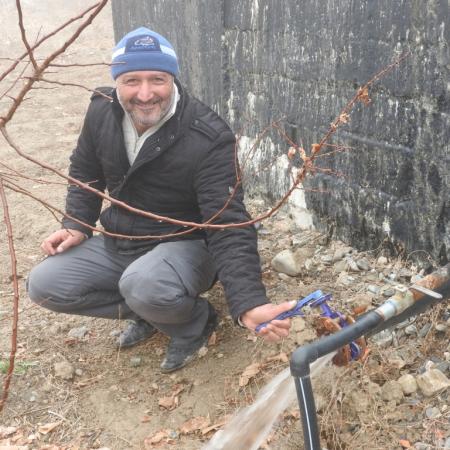
Increasing human population has forced the government of Tajikistan to establish new villages on lands with very limited available irrigation water. Sadulloh is one of the inhabitants of such a new settlement, located near the district center of Shahriston. Before the houses were built the land had been used for rainfed agriculture and livestock grazing. The loamy soil permits for the cultivation of fruit trees and orchards only where irrigation water is available. But the water delivered by a pipeline from a spring is barely sufficient as drinking water. In periods of drought the people buy water brought to the villages by a tanker at 75 Somoni (about 8 USD) for 2 cubic meters. So even no house gardens could be irrigated.
The solution would be to capture as much as possible of the rainfall. Precipitation is unreliable and often occurs in few, short and heavy rainshowers. Sadulloh together with the project engineers modified the gutters at his house to capture the water from the roof. A concrete reservoir was built, large enough to collect sufficient water during the wet season to irrigate his house garden.
For making the best use of the irrigation water Sadulloh with the help of the project engineers installed a drip irrigation system, which supplies more than two dozen fruit trees - apples, pears, peaches, apricoats, mulberries - as well as his vegetables. So he can produce enough for his extended family of eight people. Now the technology is copied by his neighbors.
